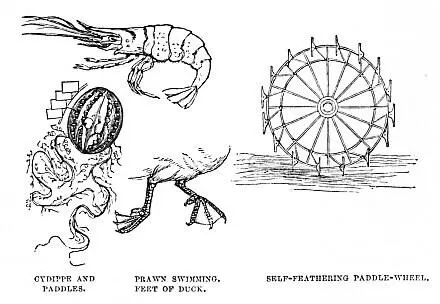John George Wood - Nature's Teachings
Здесь есть возможность читать онлайн «John George Wood - Nature's Teachings» — ознакомительный отрывок электронной книги совершенно бесплатно, а после прочтения отрывка купить полную версию. В некоторых случаях можно слушать аудио, скачать через торрент в формате fb2 и присутствует краткое содержание. Издательство: Иностранный паблик, Жанр: foreign_antique, Природа и животные, foreign_edu, на английском языке. Описание произведения, (предисловие) а так же отзывы посетителей доступны на портале библиотеки ЛибКат.
- Название:Nature's Teachings
- Автор:
- Издательство:Иностранный паблик
- Жанр:
- Год:неизвестен
- ISBN:нет данных
- Рейтинг книги:5 / 5. Голосов: 1
-
Избранное:Добавить в избранное
- Отзывы:
-
Ваша оценка:
- 100
- 1
- 2
- 3
- 4
- 5
Nature's Teachings: краткое содержание, описание и аннотация
Предлагаем к чтению аннотацию, описание, краткое содержание или предисловие (зависит от того, что написал сам автор книги «Nature's Teachings»). Если вы не нашли необходимую информацию о книге — напишите в комментариях, мы постараемся отыскать её.
Nature's Teachings — читать онлайн ознакомительный отрывок
Ниже представлен текст книги, разбитый по страницам. Система сохранения места последней прочитанной страницы, позволяет с удобством читать онлайн бесплатно книгу «Nature's Teachings», без необходимости каждый раз заново искать на чём Вы остановились. Поставьте закладку, и сможете в любой момент перейти на страницу, на которой закончили чтение.
Интервал:
Закладка:
En passant , I may remark that the familiar term of “water,” when applied to diamonds, is owing to their appearance when placed in distilled water. Those which can be at once seen are called stones of the second water. Those which cannot be seen, because their refractive powers are equal to those of the water, are called “diamonds of the first water,” and are very much more valuable than the others.
As the Cydippe is, in fact, little more than sea-water, entangled in the slightest imaginable and most transparent tissue of animal fibre, it is evident that the water and the Cydippe must be of almost equal refracting power, and that therefore the acaleph must be as invisible as diamonds of the “first water.” Indeed, I have often had specimens in a glass jar which were absolutely invisible to persons to whom I wished to show them.
But an experienced eye detects the creature at once. Along its body, at equal distances, are eight narrow bands, over which the colours of the rainbow are, though very faint, perpetually rippling. This appearance is caused by the machinery which impels the body, and which seems never to cease. Each of these bands is composed of a vast number of tiny flaps, which move up and down in regular succession, so as to cause the light to play on their surfaces. And, as they move as if set on hinges, they of course offer no resistance to the water after their stroke is made.

Now let us compare these works of nature with those of art. We have already seen the parallels of the oar, and we now come to those of the paddle-wheel. When paddle-steamers were first invented, the blades were fixed and projected from the wheel, as if they had been continuations of its spokes. It was found, however, that a great waste of power, together with much inconvenience, was caused by this arrangement. Not only was a considerable weight of water raised by each blade after it passed the middle of its stroke, but the steam power was given nearly as much to lifting and shaking the vessel as to propulsion.
A new kind of paddle-wheel was then invented, in which the blades were ingeniously jointed to the wheel, so that they presented their flat surfaces to the water while propelling, and their edges when the stroke was over. This, which is known by the name of the “Self-feathering Paddle-wheel,” was thought to be a very clever invention, and so it was; but not even the inventors were likely to have known that if they had only looked into the book of Nature, they might have found plenty of self-feathering paddle-wheels, beside the few which my limited space enables me to give.
If the reader will look at the illustration, he will see that on one side is represented the self-feathering paddle-wheel of Art, with its ingenious arrangement of rods and hinges. On the other side there comes, first, the common Prawn, shown with its tail expanded in the middle of its stroke.
Just below it is a Cydippe of its ordinary size, showing the paddle-bands, one of which is drawn at the side much magnified, so as to show the arrangement of the little paddles. As to the tentacles which trail from the body, we shall treat of them when we come to our next division of the subject of the work.
Lastly, there is a representation of the self-feathering feet of the Duck, the left foot expanded in striking the water, and the right closed so as to offer no resistance when drawn forward for another stroke. The swan’s foot shows this action even more beautifully than does that of the duck.
We now come to another mode of propulsion, namely, that which is not due to direct pressure of a more or less flat body against the water, but to the indirect principle of the screw, wedge, or inclined plane.
Space being valuable, I will only take two instances, namely, the well-known mode of propelling a boat by a single oar working in a groove or rowlock in the middle of the stern, and the ordinary screw of modern steamers.
Most of my readers must have seen a sailor in the act of “sculling” a boat. A tolerably deep notch is sunk in the centre of the stern, and the oar is laid in it, as shown in the central illustration, on the right-hand side. The sailor then takes the handle of the oar, and works it regularly backwards and forwards, without taking the blade out of the water. The boat at once begins to move forward, and, when the oar is urged by a strong and experienced man, can be propelled with wonderful speed. The well-known “Tanka” boat-girls of China never think of using two oars, a single oar in the stern being all-sufficient for the rapid and intricate evolutions required in their business.
The mechanical process which is here employed is nothing more than that of the inclined plane, or rather, the wedge, the oar-blade forming the wedge, and the force being directed against the stern of the boat, and so driving it through the water.
The Rudder affords another example of a similar force, although it is used more for directing than propelling a vessel. Still, just as the scull is used not only for propelling, but for steering the boat, the rudder, when moved steadily backwards and forwards, can be used for propulsion as well as steerage. In the absence of oars, this property is most useful, as I can practically testify.
So different in appearance are the screw and the inclined plane, that very few people would realise the fact that the screw is nothing but an inclined plane wound round a cylinder, or rather, is a circular inclined plane. The ordinary corkscrew is a good example of this principle, the cylinder being but an imaginary one.
Now, if the screw be turned round, it is evident that force is applied just on the principle of the wedge, and this principle is well shown in the various screw-presses, of which the common linen-press is a familiar example, as was the original printing-press, which still survives as a toy for children.
We all know the enormous force exerted by screws when working in wood, and how, when the screw-driver is turned in the reverse direction, the instrument is forced backwards, though the operator is leaning against it with all his weight. In fact, a comparatively small screw, if working in hard wood or metal, so that the threads could not break, could lift a heavy man.
Substitute water for wood or metal, and the result would be the same in principle, though the resistance would be less. As the loss of power by friction would prevent a large vessel from being propelled by a stern oar moved like a scull, the idea was invented of applying the same kind of power by a large screw, which should project into the water from the stern of the vessel. This modification, moreover, would have the advantage of forcing the vessel forward when the screw was turned from left to right, and drawing it back when turned in the opposite direction, whereas the sculling oar would only drive it forward.
The principle was right enough, but there was at first a great difficulty in carrying it out. Firstly, several turns of a large screw were used, and were found to need power inadequate to the effect. Then the screw was reduced to four separate blades, and now only two are used, as shown in the illustration, these saving friction, being equally powerful for propulsion, and running less risk of fouling by rigging blown overboard or other floating substances.
So much for Art. Now for the same principle as shown in Nature, of which I can take but a very few instances.
The first and most obvious example is that of the Fish-tail, which any one may observe by watching ordinary gold fish in a bowl. Their progression is entirely accomplished by the movement of the tail from side to side, exactly like that of the sculling oar, and moreover, like the oar, the tail acts as rudder as well as propeller.
Читать дальшеИнтервал:
Закладка:
Похожие книги на «Nature's Teachings»
Представляем Вашему вниманию похожие книги на «Nature's Teachings» списком для выбора. Мы отобрали схожую по названию и смыслу литературу в надежде предоставить читателям больше вариантов отыскать новые, интересные, ещё непрочитанные произведения.
Обсуждение, отзывы о книге «Nature's Teachings» и просто собственные мнения читателей. Оставьте ваши комментарии, напишите, что Вы думаете о произведении, его смысле или главных героях. Укажите что конкретно понравилось, а что нет, и почему Вы так считаете.












